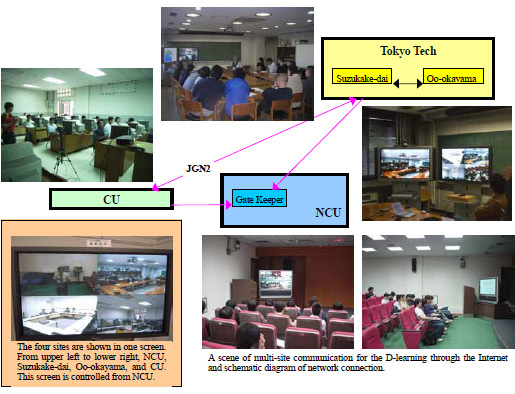| H. Morikawa (TokyoTech)
Anat Ruangrassamee (Chulalongkorn Univ.)
H.-T. Chen (National Central Univ.)
1. Introduction
The great Sumatra Earthquake (Mw9.0) of December 26th, 2004 brought destructive damage to the countries around the Indian Ocean. After this poignant experience, we realized the importance of the appropriate knowledge on the earthquake and Tsunami disaster again. Thus, in March 2005, a mission team of the Center for Urban Earthquake Engineering (CUEE), Tokyo Institute Technology made a proposal on a distance learning (D-learning) program for graduate students in Asian countries.
For the first season, 2005-2006, we only offered the D-leaning course between Chulalongkorn University (CU), Thailand and Tokyo Institute of Technology (Tokyo Tech), Japan. The details of the course of 2005-2006 season has been reported in Japanese on the CUEE News letter No.4 (March, 2006). Despite facing many difficulties, we learned many things with respect to the international joint course, enabling us to include the National Central University (NCU), Taiwan, R.O.C. as the new counterpart for the international course for the 2006-2007 semester. In this short report, we will describe the outline of the course.
2. Contents and Lecture Arrangement
With the above-mentioned aim in mind, the course is entitled “Earthquake and Tsunami Disaster Reduction.” The contents include the following seven topics and 90-minute lectures are carried out every week for seven weeks:
| ・Earthquake Ground Motion (Dr. Yamanaka) |
・Earthquake-induced Disaster (Dr. Seo) |
| ・Tsunami Science (Dr. Ohmachi) |
・Risk Management (Dr. Morikawa) |
| ・Real-time Information (Dr. Midorikawa) |
・Earthquake Hazard Mitigation (Dr. Kasai) |
| ・Tsunami Hazard Mitigation (Dr. Hiraishi) |
|
For the semester of 2006-2007, three universities were involved, and we encountered difficulty in arranging lecture hour due to the fact that three universities have different starting date of semester and holidays and furthermore we have to consider the time difference among the three countries: +0700 in Thailand, +0800 in Taiwan, and +0900 in Japan. As a result, the class hour was set to be in the Friday afternoon for seven weeks, starting 13:00 in Thailand, 14:00 in Taiwan and 15:00 in Japan, respectively.
Photographs in the next page show the lecture rooms for the D-learning system in each university. Regularly, more than 30 students and academic staffs attended the course from the three universities. Since the students are generally shy, they make few questions. The Q &A session can become more active if we contrive a good atmosphere for students to speak something, for example, we implement such a Q&A web-board.
3. System for D-learning
We used the Internet TV conference system, which was produced by Polycom Inc. In the first season, 2005-2006, it was not so difficult to connect between CU and Tokyo Tech, because the system can be used under the default configurations. At the end of December, 2005, a new broad band connection was made available between Thailand and Japan, which is named Japan Gigabit Network 2 (JGN2), and we changed the route for the packets. However, because of the security policy, the network operation center at CU did not agree to change the configuration of route and their firewall in that time.? Consequently, the packets from Japan to Thailand went through JGN2, but the packets came back via another way (maybe, USA). Even so, the round trip time (RTT) was reduced to about 100ms from 200ms after the opening of JGN2 and we can obtain enough quality for not only the video image and voice but also the animation on PC. In the second season, 2006-2007, originally we planned to deliver the lectures from Suzukake-dai campus of Tokyo Tech to CU, NCU, and Oo-okayma campus of Tokyo Tech. This means that we have to acquire the multi-site connection. The system at Tokyo Tech cannot complete the multi-site connection if the first connection is not established from the system at Tokyo Tech to the remote system.? Unfortunately, since a port is blocked by the firewall at CU, the system of Tokyo Tech cannot be used as the server for the multi-site connection. This was very serious problem for our projects.? However, to avoid this problem, we concentrated the packets for the TV conference to the “gate keeper” at NCU and then, the packets were re-distributed to CU and Tokyo Tech. With this, the packets did not pass through JGN2. Although the connection is not so broad as before, it was much better than no connection.? Figure below shows a schematic diagram for the multi-site connection.
In the end of 2006, a slightly big earthquake hit Southern Taiwan, damaging many submarine cables between Taiwan and Thailand or Taiwan and Japan. After that event, many routes including JGN2 were down for long time and it was very difficult to keep the broad connection among three universities. At the final lecture on the first week of January, 2007, the quality of the video and voice was very poor; furthermore, the connection was sometimes lost and it was difficult to communicate smoothly. We, however, completed the lecture under the poor condition.
4. Review
After the first season, we sent a questionnaire sheet to the students of CU and asked their comments on the course. Generally speaking, they are satisfied with the course, deeming that it provided a good opportunity for foreign students to communicate with each other. Usually, they know only their own university, but to catch a glimpse of the atmosphere of foreign university must be a good experience.
Acknowledgments:
The authors wish to thank Prof. Panitan Lukkumaprasit of CU for the kindness and leadership to continue this project. Furthermore, we gratefully acknowledge the warmest support for this project with the following people: Prof. A. Nishihara of Center for Research and Development of Educational technology, Tokyo Tech; Dr. M. Kakuta, Dr. K. Iida, and Dr. S. Shinomiya of the Network Operation Center, Tokyo Tech; Mr. Chanin Maharak and Mr. Sanya Vasoppakarn of CU; Mr. Where Paul of Computer Center, NCU.

|
